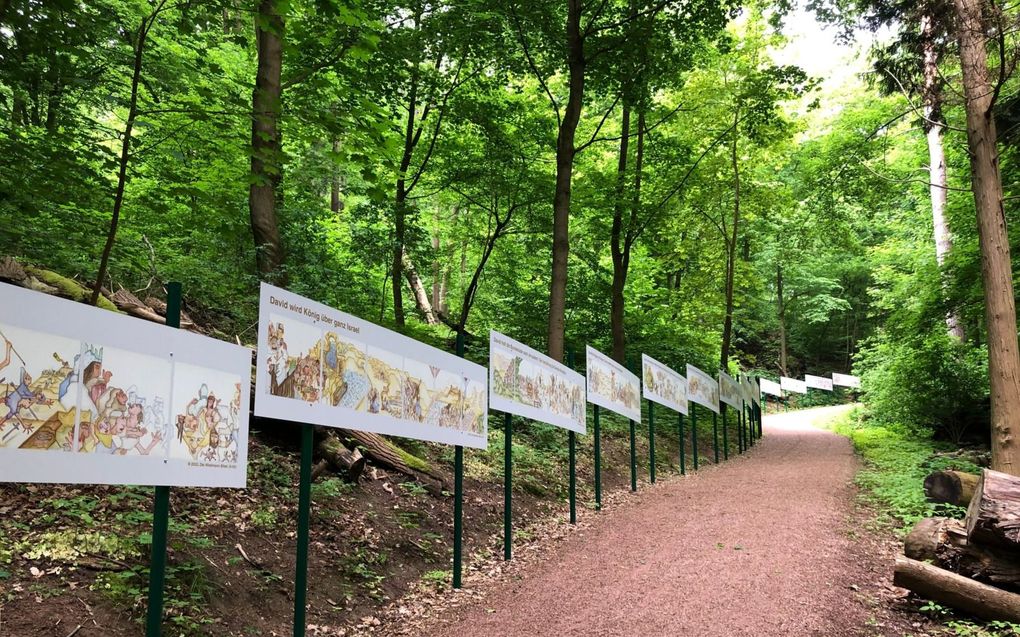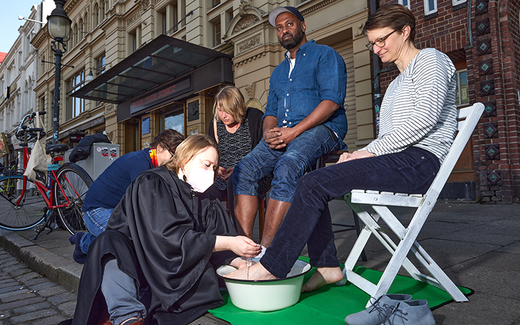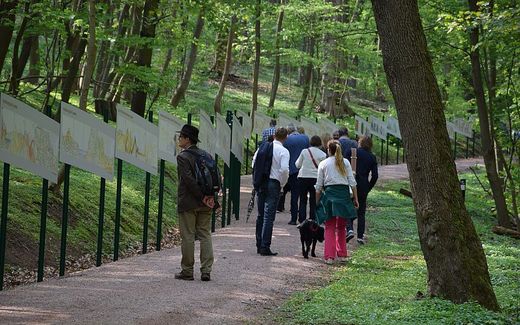Longest Bible of the world takes hiker to the Wartburg
31-05-2022
Central Europe
Geerten Moerkerken, RD

The Wiedmann Bible in Eisenach. Photo RD
Central Europe
Its length of 1.2 kilometres and its 3333 images make it the longest Bible in the world: The Wiedmann Bible. The unique piece of art is located on the German hills close to the Wartburg castle.
The Wartburg castle is located at a height of 440 metres. People who want to visit the castle by foot, will thus have to do quite a bit of climbing. But there is enough to see on the way there. Whoever takes the quickest route to the top, will pass by the “Luthererlebnispfad” (translated as Luther experience path), which contains boards full of information about the reformer Martin Luther and quotes from him.
Anyone who has time for a longer walk can choose to follow the “Rosenwanderweg” (translated as Rose Trail). That route contains a unique exhibition since last month: de “Eisenacher Pilgerbible”, the Pelgrim Bible of Eisenach. The artwork consists of 3333 paintings which portray the whole Bible together. The images are placed on large boards on the roadsides of the trail to the top: from Genesis in Eisenach until Revelations, on top of the hill by the Wartburg castle, about 2 kilometres away.
Total length of the work is more than a kilometre
It is the lifework of the German artist Willy Wiedmann (1929-2013). The entrance gate of the exhibition at the Reuter road shows his face and story. The gifted man practised several crafts: painter, sculptor, musician and composer among others. But Wiedmann's favourite thing to do was painting church buildings.
During one of his assignments, in the Pauluskriche in Stuttgart, he got the idea to translate the whole Bible, chapter by chapter, into images. He started his work in Ieporellos: concertina folded papers. The work would become his lifework: Wiedmann painted for 16 years, based on 40 different Bible translations, until he painted all Bible books in 16 Ieperellos. The total length of his work: about 1170 metres. Never before had the whole Bible been translated into images.
One important characteristic of Wiedman's paintings is a style that he called “Polykon painting.” The basis of that style are geometric shapes, such as many squares and triangles, and a rich palet of colours.
Made for the common man
The exhibition in Eisenach, that started on May 4, is the first occasion that shows the so-called Wiedmann Bible fully in this way, so it is a world premiere. The date of May 4 is not an accidental date: 501 years ago, Luther's carriage halted in the woods surrounding Altenstein castle. The reformer – on his way back to Wittenberg after his defence on the Diet of Worms – was kidnapped. After his fake kidnap, he arrived that night at the Wartburg castle. There, he would work on his life work: the German Bible translation. In 1522 the first version of ‘his’ New Testament was published: the September Testament.
The Luther Bible – which is exactly 500 years old this year – and Wiedmann's project have many similarities, Cornelia Hartleb says. She is a city guide and shows the exhibition on Wiedmann in the city castle, where also the Ieporellos can be seen. Just like Luther, Wiedmann wanted to reach out to the common people, Hartleb says. “He wrote that those who are afraid to read the Bible because they do not understand the written text, can profit from his work. He wanted to give them a new “entrance” to the Bible, and hoped that they could find the Word through his work, regardless of their language.”
No time for the children
Nevertheless, during his life, Wiedmann was never able to reach a large public with his Bible. He did not have the means to publish his work or to bring it in the spot lights. Thus, the longest Bible of the world disappeared in four archive boxes, somewhere in his studio.
Not until after the death of the artist in 2013, his son Martin found the Bible when he was cleaning up the possessions of his father, Hartleb tells. “Including the notes of Wiedmann, who explains the meaning of his artwork. Martin never knew of this project on which his father worked for 16 years. When I asked how this was possible, he said: “My father was always so busy with his art, that he did not have much time to spend with his children.””
Martin Wiedmann, nevertheless, took the responsibility to publish the life work of his father. He ensured that the thousands of images were digitalised.
Translating is interpreting
The way to the Wartburg is quiet, on this morning in May. Only at the location of Exodus, one hiker passes with his dog. We must search a bit to find out how the exhibition can best be experienced. Every single image has enough to think about. Who walks past the whole Bible with much attention, will take more than a week to arrive at the Wartburg.
No one reads the whole Bible in one morning. The same applies to the Wiedmann Bible. Walking, you pass the different chapters, sometimes with well-known and other times with lesser known Biblical histories. The requirements for sacrifices from Leviticus, Ruth on the field of Boaz, Isaiahs song on the winery. Sometimes, an image invites you to stay a bit longer. Moreover, there are different ways to reach the top. Many times, it is possible to choose a shorter path and skip some of the Bible books.
Translating is always interpreting. That also turns out to be true for Wiedmann's life work. The exhibition leaves it up to the visitor, so the accompanying text states. “The Wiedmann Bible does not attempt to convince, it only tries to invite and stimulate.” At the same time, the translation to images is never unbiased. Therefore, many things happen, and it would be worth your time to study the whole work of art to discover Wiedmann's vision. One example of the choices that the artist made: by the portrayal of the fall into sin, from Genesis 3, it is male arm who gives Eve the fruit.
An expensive book
Visitors will differ in their appreciation of the work. The paintings are very abstract sometimes, in other cases, they portray God and Wiedmann also shows naked people in his paintings. Yet, the whole work shows that the artist respected the Bible and attempted to listen to the texts itself.
The exhibition in Eisenach is open until October. Who wants to buy the paper version of the Bible – existing of two volumes – will have to pay about 600 euros. However, the full work is also available via the app store; there, the Bible app is much more affordable with its price of 10 euros.
This article was translated by CNE.news and published earlier in Dutch daily Reformatorisch Dagblad on May 31, 2022
Related Articles





